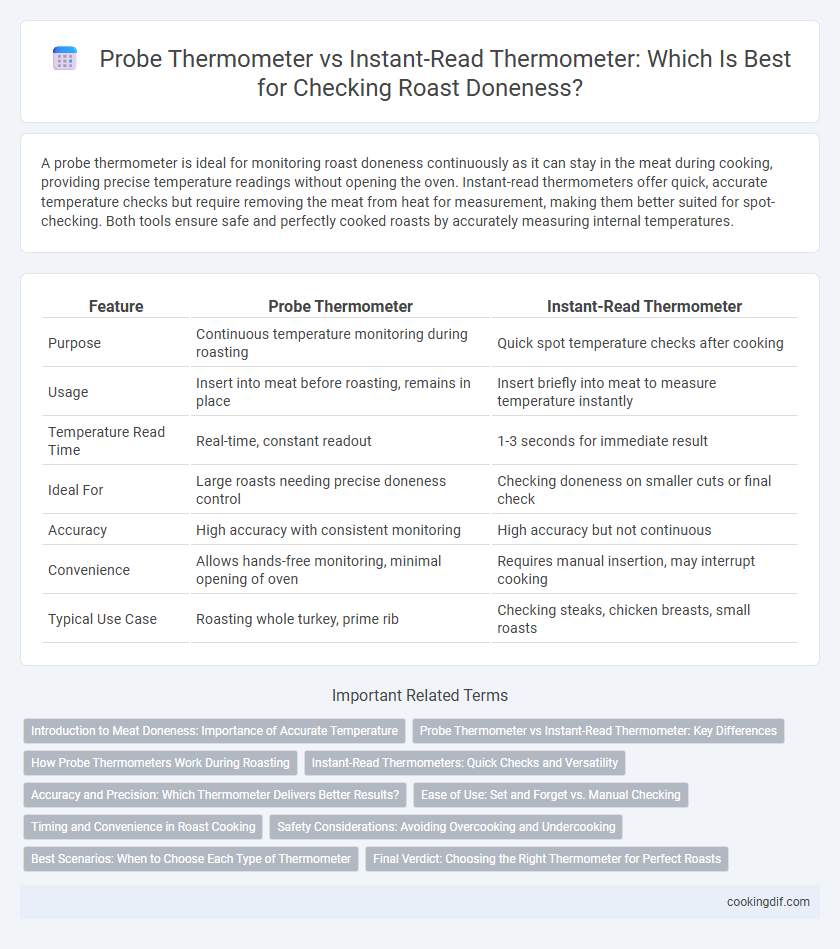A probe thermometer is ideal for monitoring roast doneness continuously as it can stay in the meat during cooking, providing precise temperature readings without opening the oven. Instant-read thermometers offer quick, accurate temperature checks but require removing the meat from heat for measurement, making them better suited for spot-checking. Both tools ensure safe and perfectly cooked roasts by accurately measuring internal temperatures.
Table of Comparison
| Feature | Probe Thermometer | Instant-Read Thermometer |
|---|---|---|
| Purpose | Continuous temperature monitoring during roasting | Quick spot temperature checks after cooking |
| Usage | Insert into meat before roasting, remains in place | Insert briefly into meat to measure temperature instantly |
| Temperature Read Time | Real-time, constant readout | 1-3 seconds for immediate result |
| Ideal For | Large roasts needing precise doneness control | Checking doneness on smaller cuts or final check |
| Accuracy | High accuracy with consistent monitoring | High accuracy but not continuous |
| Convenience | Allows hands-free monitoring, minimal opening of oven | Requires manual insertion, may interrupt cooking |
| Typical Use Case | Roasting whole turkey, prime rib | Checking steaks, chicken breasts, small roasts |
Introduction to Meat Doneness: Importance of Accurate Temperature
Accurate temperature measurement is essential for determining meat doneness, ensuring food safety and optimal flavor. Probe thermometers provide continuous monitoring during roasting, allowing precise control of internal temperature without opening the oven. Instant-read thermometers offer quick temperature checks but require removing the meat, potentially causing heat loss and uneven cooking.
Probe Thermometer vs Instant-Read Thermometer: Key Differences
Probe thermometers feature a metal probe that remains in the roast during cooking, providing continuous internal temperature monitoring essential for precise doneness without opening the oven. Instant-read thermometers require manual insertion and deliver quick temperature readings on demand, ideal for spot checks but less effective for continuous monitoring. Choosing between a probe and instant-read thermometer depends on cooking style, with probe thermometers favored for consistent accuracy and instant-read models preferred for rapid, flexible checks.
How Probe Thermometers Work During Roasting
Probe thermometers monitor the internal temperature of a roast continuously by remaining inserted throughout the cooking process, providing real-time data without opening the oven. These devices use a heat-resistant probe connected to a digital display, allowing precise tracking of meat doneness levels from rare to well-done. This constant temperature monitoring ensures accurate cooking, preventing overcooking or undercooking while maintaining optimal moisture and flavor.
Instant-Read Thermometers: Quick Checks and Versatility
Instant-read thermometers provide rapid and accurate temperature readings, making them ideal for quick doneness checks during roasting. Their versatility allows cooks to test various types of meat, ensuring food safety and optimal texture without interrupting cooking for long periods. Compared to probe thermometers, instant-read models offer greater flexibility and are especially useful for monitoring internal temperatures at critical moments.
Accuracy and Precision: Which Thermometer Delivers Better Results?
Probe thermometers provide greater accuracy and precision for roast doneness by continuously monitoring internal temperature during cooking, ensuring even heat distribution. Instant-read thermometers offer quick spot checks but may be less reliable for consistent results due to potential temperature fluctuations. For precise roast cooking, a probe thermometer delivers superior performance in maintaining target doneness levels.
Ease of Use: Set and Forget vs. Manual Checking
Probe thermometers offer ease of use by allowing continuous monitoring of roast doneness with a "set and forget" feature, eliminating the need for repeated manual checks. Instant-read thermometers require opening the oven and manually inserting the probe, which can lead to heat loss and inconsistent temperature readings. For precise, hands-off cooking, a probe thermometer provides real-time data without interrupting the roasting process.
Timing and Convenience in Roast Cooking
A probe thermometer offers continuous monitoring by staying in the roast throughout cooking, ensuring precise timing without opening the oven and losing heat. Instant-read thermometers provide quick, accurate temperature checks but require pausing the cooking process to insert and remove the device, potentially disrupting timing. For convenience and consistent doneness, probe thermometers excel in maintaining optimal roast temperature with minimal effort.
Safety Considerations: Avoiding Overcooking and Undercooking
Probe thermometers provide continuous monitoring of roast temperature, enabling precise control to avoid undercooking, which poses foodborne illness risks, and overcooking, which affects texture and flavor. Instant-read thermometers offer quick, accurate temperature checks at critical moments but require repeated checks that can cause heat loss. Selecting the appropriate thermometer ensures food safety by confirming the roast reaches the USDA-recommended internal temperature for doneness, typically 145degF (63degC) for beef.
Best Scenarios: When to Choose Each Type of Thermometer
A probe thermometer is ideal for slow-cooked roasts, offering continuous internal temperature monitoring without opening the oven, ensuring precise doneness over prolonged cooking times. An instant-read thermometer suits quick temperature checks during resting or slicing, providing immediate feedback for shorter cook times or final adjustments. Choosing between the two depends on whether ongoing monitoring or rapid, spot checks best fit the cooking process.
Final Verdict: Choosing the Right Thermometer for Perfect Roasts
Probe thermometers provide continuous temperature monitoring during roasting, ensuring consistent doneness without opening the oven, while instant-read thermometers offer quick internal temperature checks at any stage for precise results. For perfect roasts, probe thermometers are ideal for hands-off cooking and maintaining even heat, whereas instant-read thermometers excel in final accuracy and quick adjustments. Choosing between the two depends on cooking style and preference for real-time data versus rapid temperature verification.
Probe thermometer vs Instant-read thermometer for doneness Infographic

 cookingdif.com
cookingdif.com